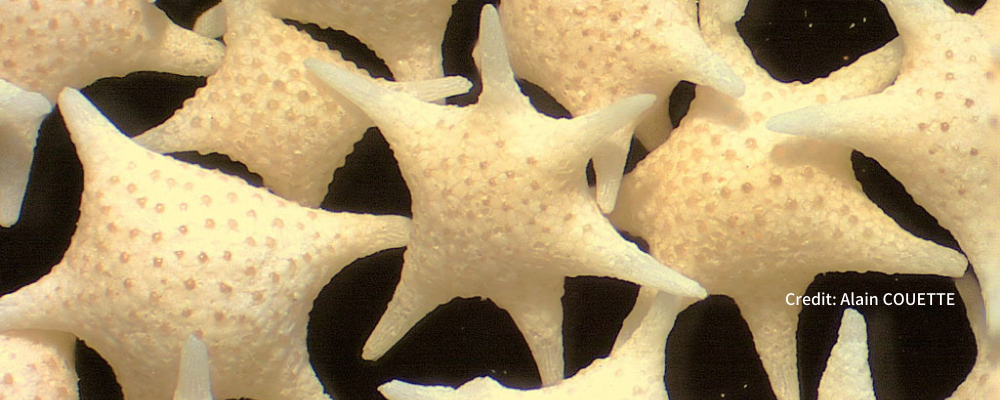USGS -United States Geological Survey- アメリカ地質調査所 による海洋科学用語解説 WaterWrods から、ここでは Foraminifera 有孔虫 と Infauna 埋在動物 を取り上げます。
日常生活では聞きなれない言葉ですしなかなか使うこともないかもしれませんが、科学知識に触れたり雑学として聞いたりするのは楽しいですよね!
いったいどんな内容なのか、専門用語や英語表現と合わせてみていきたいと思います。
Contents
Foraminifera:有孔虫
定義
白い砂浜で星の形をしたいわゆる“星の砂”を見たことがありませんか?
お土産などにもなっていますね。
これは実は foraminifera 有孔虫 と呼ばれる原生生物の殻なのです。
Foraminifera are a group of protists similar to amoebas that mostly live in the world’s oceans. Many of them live in the benthic sediments, though some float in the water column.
USGS | WaterWords–Foraminifera より引用
Foraminifera eat a wide variety of things, and some species even steal chlorophyll from the algae they eat to do their own photosynthesis.
この有孔虫は世界中の海に生息しているそうです。
多くは海底の堆積物中にいるようですが、一部は海中を漂っているようです。
有孔虫はいろんなものを食料とするようですが、藻類を食べてその葉緑素を自身の光合成に利用する種類のものもいるそうです。
sediment は こちらの記事 で解説していますが、堆積物 という意味です。
語源
Foraminifera の語源はラテン語の hole bearers から来ています。
Foraminifera comes from the Latin for “hole bearers.”
USGS | WaterWords–Foraminifera より引用
hole は 穴、bearer は 運ぶ人・担い手 という意味ですので、合わせて 穴のある生物 → 有孔虫 となるのですね。
地球自然環境における働き
Foraminifera 有孔虫 は海洋の、特に海底の食物連鎖において重要な役割を果たしています。
Foraminifera are an important part of many ocean food chains, especially benthic ones. In addition, as they die, their bodies fall through the ocean until they reach the seafloor, helping to form ocean sediments.
USGS | WaterWords–Foraminifera より引用
Some oil and gas companies use the foraminifera fossils they find in cores to help evaluate the age of the rock and look for oil and gas deposits.
死後その死骸は海底まで落ちていき、海底堆積物を形成します。
一部の石油会社などは、岩石の年代を見積もったり、石油やガスの鉱床を探したりするのに、地質調査サンプルの中にある foraminifera 有孔虫 の化石を利用しています。
Infauna:埋在動物
定義
海底の堆積物の中にも生物は棲んでいます。
深海の海底堆積物の中の住人たちは、infauna 埋在動物 として知られています。
Some species are content to simply perch on the surface of the seafloor sediments, whereas others prefer to dive into the dirt on the ocean floor. These deep-sea dwellers in marine sediments are known as infauna.
USGS | WaterWords-Infauna より引用
dweller は 居住者・居住動物 という意味です。
その動詞形の派生語である dwell は こちらの記事 で解説していますが、住む・居住する という意味です。
語源
infauna の語源はラテン語の fauna から来ています。
Infauna comes from the Latin fauna, a Roman fertility goddess.
USGS | WaterWords-Infauna より引用
fauna はローマ神話における豊饒の女神のことだそうです。
地球自然環境における働き
infauna 埋在動物 は海底の生態系において重要な役割を果たしています。
Infauna are an important part of the benthic ecosystems at the bottom of the ocean. They help process the nutrients that fall from above and serve as critical food resources for other seafloor dwellers, including crabs and fish.
USGS | WaterWords-Infauna より引用
In addition, when they die, their corpses help form the deep-sea sedimentary rocks that make up the seafloor.
上から落ちてきた栄養源を分解し、そして自身もカニや魚などの重要な食料源となっています。
そしてその死骸は海底そのものを形成する深海堆積物となります。
用語と表現
protist:原生生物
protist は 原生生物 のことです。
原生生物 というのは生物の分類の一つで、真核生物と呼ばれる生物の中で動物でも植物でも菌類でもない生物の総称です。
アメーバやゾウリムシ、粘菌などがこの protist 原生生物 に分類されます。
Wikipedia による原生生物の解説は こちら 。
benthic:底生の・底生性の
benthic は 底生の・底生性の という意味です。
海などの底に生息している生物やその特徴を表現する際に使われます。
chlorophyll:葉緑素
chlorophyll は 葉緑素 のことです。
植物が光合成によって光からエネルギーを利用しているのはこの葉緑素のおかげですね。
Wikipedia による葉緑素の解説は こちら 。
algae:藻類
algae は 藻類・藻 のことです。
algae は複数形で、alga が単数形になります。
発音記号は ˈældʒiː です。
be content to ~:~に満足している
be content to ~ は ~であること/~することに満足している という意味です。
状態や動作に満足している場合は to を使います。
何かの物だったり、名詞で表現される状況やポジションなどが続く場合は with を使って be content with ~ となります。
corpse:死骸・死体
corpse は 死骸・死体 のことです。
同義語に
- cadaver:死体・遺体(主に人間の)
- carcass:死体・死骸(主に動物の)
があります。
まとめ
Foraminifera 有孔虫 と Infauna 埋在動物 という、海洋生物についての海洋科学用語の解説でした。
なかなか日常生活を送る中では実感がわきませんが、海洋中や海底世界ではこれらの生物が生態系の維持に大切な役割を果たしているようです。
今度もし星の砂を見る機会があった際には foraminifera 有孔虫 のことに思いをはせてみるのもいいかもですね。


